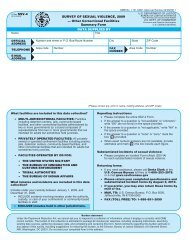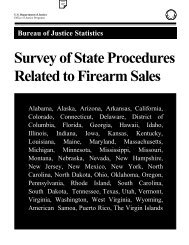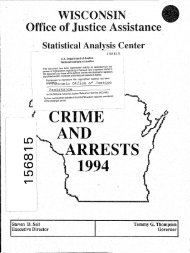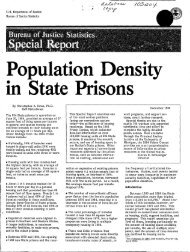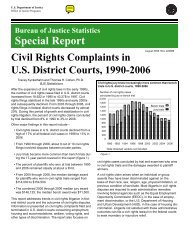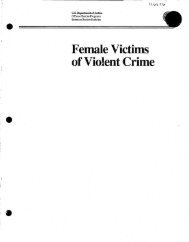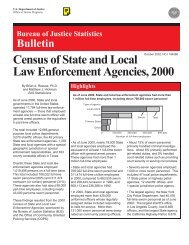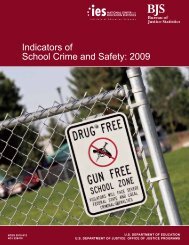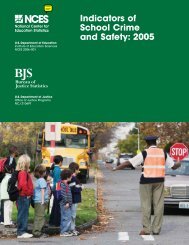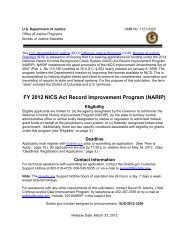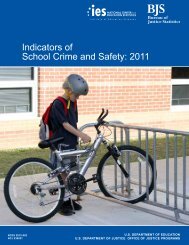<strong>Sourcebook</strong> <strong>of</strong> <strong>Criminal</strong> <strong>Justice</strong> <strong>Statistics</strong> <strong>1983</strong>Sources and ReferencesFolan, Rita. Status <strong>of</strong> Offender Based Transaction <strong>Statistics</strong>(OBTS) System Development in the States. Washington, D.C.:<strong>Criminal</strong> <strong>Justice</strong> <strong>Statistics</strong> °Association, Inc., 1981.Contents:129 pages, 23 tables,' 20 figures, 3 appendicesDates <strong>of</strong> data presented:1980 and 1981Periodicity:SpecialSOlRCEBOO< table:1.83The report pre!!:lnts results <strong>of</strong> a survey <strong>of</strong> directors <strong>of</strong> StateStatistical Analysis Centers (SAC). The survey was designed to assessthe status <strong>of</strong> the development <strong>of</strong> <strong>of</strong>fender based transaction statistl cs(OBTS) systems and to determine the level <strong>of</strong> analysis reasonablyexpected <strong>of</strong> the current or planned data. Topics addressed In thereport are: an overview <strong>of</strong> <strong>of</strong>fender based statistics systems, by State;the development and use <strong>of</strong> <strong>of</strong>fender based statistics, by State; quality<strong>of</strong> OB TS system data; and examples <strong>of</strong> OBTS systems in Oregon, NewYork, and Pennsylvania. The appendic:es include a copy <strong>of</strong> the surveyinstrument, Puerto Rico's response to the survey, and a listing <strong>of</strong> thecategories <strong>of</strong> OBTS system development used throughout the report.* * *Gallup, George H. The Gallup Poll. Princeton, N.J.: The C.gl/up Poll.Contents:See narrativeDotes <strong>of</strong> data presented:See narrativePeriodicity:See narrat iveSOlRCEBOO< tables:2.20, 2.72, 2.85, 2.92, 2.96, 2.98, 2.112, Fig. 2.10, Fig. 2.15, Fig.2.19The results <strong>of</strong> public opinion research condJcted by the Gal/uporganization are released every Sunday and Thursdu!, in The GallupPall. A wide variety <strong>of</strong> topics are included in these surveys includingeconomic policy, fear <strong>of</strong> crime, and the legalization <strong>of</strong> marihuana. Abrief note on sample size, sample tolerance, and survey dates isincluded in each release.* * *Gal/up, George H. The Gallup Report. Princeton, N.J.: The GallupPoll.Contents:See narrativeDates <strong>of</strong> daola presented:See naf nit i vePeriodicity:Monthly5O.RCEBOO< tables:2.2, 2.4-2.6, 2.14-2.16, 2.20, 2.21, 2.35, 2.50, 2.61, 2.66, 2.69-2.", 2.73-2.80, 2.82, 2.83, 2.86, 2.92, 2.95, 2.97-2.99, 2.110,2.1 II, 3.37, 3.38, Fig. 2.I-Fig. 2.3, Fig. 2.18The Gallup Report contains the results <strong>of</strong> opinion surveysconducted by the Gal/up Poll. Political, social, and economic trendsare presented in issues that include many topics (e.g., April 1981-presidential safety, crime, political parties, and EI Salvador). A briefnote on sample size, sampling toleronce, and survey dates is Includedin eoch issue.* * *Gaynes, Elizabeth. "Typology <strong>of</strong> State Laws Which Permit theConsideration <strong>of</strong> Danger in the Pretrial Release Decision." PretrialServices Resource Center, 1982. (Mimeographed.)Contents:32 pages, I table, 6 appendicesDates <strong>of</strong> data presented:1982Periodicity:Special5O.RCEBOO< table:1.69622This report describes State constitutional requirements, statutes,and court rules regarding the consideration <strong>of</strong> potentially dangerous orcriminal behavior in pretrial release decisions, The appendices containconstitutional and statutory provisions relating to pretrial release, acopy <strong>of</strong> the Bail Reform Act <strong>of</strong> 1966, and performance standards andgoals for release and diversion.* * *Harris, Louis. The Harris Survey. Ne", York: The Chicago TrlbuneNew York News Syndicate.Contents:See narrative:Dates <strong>of</strong> data presented:See narrativePeriodicity:See narrativeSOlRCEBOO< tables:2.54, 2.68, 2.102-2.105, Fig. 2.8, Fig. 2.9, Fig. 2.11, Fig. 2.14,Fig. 2.17The Harris Survey is a twice weekly release <strong>of</strong> results <strong>of</strong> publicopinion research conducted by Louis Harris and Associates. Thereleases deal with a variety <strong>of</strong> topics including politics, economics,gun control, and law enforcement. A brief note on sample size andsurvey dates is Included in each release.* * *Insurance Information Institute. Insurance Facts 1982-83. NewYork: Insurance Information Institute., 1982.Contents:92 pages, 83 tables, 8 figuresDates <strong>of</strong> data presented:Primary period: 1981Trend tables: 1950-81Periodicity:AnnualSOlRCEBOO< figure:3.23This yearbook provides basic data on the property and liabilitysegment <strong>of</strong> the insurance industry in the United States. Statisticaldata are presented on property and liability insurance companies;policies written and in force, by type <strong>of</strong> coverage; and Insurancewritten through special programs such as flood insurance, the FederalCrime Insurance Program, and others. Data are presented oninsurance losses due to fire, natural disasters, traffic accidents, crime,and other causes.* * *Johnston, Lloyd D.; Bachman, Jerald G.; and O'Mal/ey, Patrick M.Student Drug Use, Attitudes and Beliefs, National Trends1975-1982. U.S. Department <strong>of</strong> Health and Human Services.National Institute on Drug Abuse. Washington, D.C.: U.S.Gavernment f'rinting Office, <strong>1983</strong>.Contents:134 pages, 19 tables, 37 figuresDates <strong>of</strong> data prel'llnted:Primary period: 1982Trend tables: 1975-82o Periodicity:AnnualSOlRCf:Soa< tables:2. I 06-2.1 08, 3:45-3.48, Fig. 3.18This document is the sixth in an annual series reporting drug useand related attitudes <strong>of</strong> high schaol seniors in the United States. Thereport presents only highlights <strong>of</strong> the larger volOOle that has beenpubJished by the National Institute on Drug Abuse, entitled StudentDrug Use in America: J 975- J 982. Two <strong>of</strong> the major topics treato:>dIn the report are the trends in drug use among Pmerican high schoolstudents since 1975 and the prevalence <strong>of</strong> drug use among />merlcanhigh school seniors. Also reported are data an school grade at firstuse; intensity <strong>of</strong> "high" produced by drug use; attitUdes and beliefsamong seniors about various types <strong>of</strong> drug use; and their perceptions <strong>of</strong>cel·tain ralevant aspects <strong>of</strong> the social enVironment, such as parentaldisapproval <strong>of</strong> drug use or availability <strong>of</strong> drugs.* * *Karter, Michael J. Jr. "Fire Loss In the United States During 1981."Are Journal 76(September 1982), p. 68.\\ 'I1II1 ;! I! IContents:16 pages, II tables, 4 figuresDates <strong>of</strong> data presented:Primar)' period: 1981Trend tables: 1977-81Periodicity:Annual5O.RCEBOO< table:3.94This article reports the results <strong>of</strong> the 1981 National FireExperience Survey conducted by the National Fire ProtectionAssociation. Data are presented that describe fire incidence, deaths,and property lass, by fire type (s~ructural, vehlcul,ar, and arson),conmunity size, and geographiC region. ,A methodological addend.urn tothe article details the sampling and estimation procedures used In thesurvey.* * *Kerle Kenneth E., and Ford, Francis R. The State <strong>of</strong> Our Nation'sJdils 1982. Washington, D.C.: National Sheriff's Association, 1982.Contents:233, pages, SO tables (estimated)Dates <strong>of</strong> data presented:Primary period: 1981-82Trend tables: 1800-1980 (decades)Periodicity:SpecialSOlRCEBOO< tables:1.50-1.56, Fig. 1.9This report presents sunmary analyses <strong>of</strong> the legal problems <strong>of</strong>jails, jail administration, physical d~scriptio.ns <strong>of</strong> jails! jail staffing,inmate populations, programs and servIces available to Inmate,s" andmost important problems facing jails. Data are presented for JaIls <strong>of</strong>different sizes. .The report also discusses survey methodology a~d al!e!natlvedefinitions <strong>of</strong> jails, presents sl.mmOry data on selected cIty Jails, andincludes a copy <strong>of</strong> the survey instrument.* * *Miller Judith Droitcour. National Survey on Drug Abuse: MainFI~dings 1982. U.S. Department <strong>of</strong> Health an(j HOOlan Services.National Institute on Drug Abuse. Washington, D.C.: U.S.Government Printing Office, 1982.Contents:141 pages, 80 tables, 6 appendicesDates <strong>of</strong> data presented:Primary period: 1982Trend tables: 1971, 1972, 1974, 1976, 1977, 1979 and 1982Periodicity:SpecialSQRCEBOO< tables:3.49-3.55, Fig. 3.19This report Is the seventh In a series <strong>of</strong> reports on the extent <strong>of</strong>drug abuse In the United States. The document presents informationon the prevalence, InCidence, and correlates <strong>of</strong> drug use and abuseamong adults (26 and older), young adults (/8 to 25), and youth (12 to17). Data are presented in such areas as the use <strong>of</strong> marihuana,hallucinogens, cocaine, and heroin; the medical and nonmedical use <strong>of</strong>prescription psychotherapeutic drugs; and the IJse <strong>of</strong> cigarettes andalcohol. Trend tables present comparison d
--------~~--- --- --~--- --------National Opinion Research Center. General Social Surveys 1972-82. Storrs, Conn.: Roper Public Opinion Research 'CenterU,lverslty <strong>of</strong> Connecticut, distributors.'Contents:See narrativeDates <strong>of</strong> data presented:1972-78, 1980, and 1982Periodicity:Biennial5aRCEBCXlK tables:2.23, 2.52, 2;53, 2.62-2.64, 2.89~2.91, 2.93, 2. 109, 2.113, 2.1 14,3.44, 4.19, Fig. 2.7, Fig. 2.12, Fig. 2.16, Thi~ clXllulativ: dota file merges all eight General Social SurveysInto, a single :nochlne-readable data file with each survey year as asubfile. In,tervlews "'ere conducted by the National Opinion ResearchCenter dunng Februu.y, March, and April <strong>of</strong> 1972-78 1980 and 1982The d~ta are derived from a nafional probability sa~ple df English~speaking ad~lts, 18 y:arr or older, living in non-institutionalarrongements In t~e contlnen!al !Jnited States. Survey questionsrel,a!ed to a vane,ty <strong>of</strong> ,social Issues, including politics, abortion,reli?lon, homosexuality, cnme, law enforcement guns and capitalpunishment. ' ,The items appearing on the surveys are one <strong>of</strong> three types'permanent questions that occur in each survey, rotating questions thatapp:ar two out <strong>of</strong> every three years, and a few questions that occur Ina Single survey. A comprehensive codebook entitled General SocialSurveys, 1~72-1?~2: Cumulative Codebook is published by theRoper Public Opinion Research Center. Survey methodology and thedata program are explained In detail in the document.* * *''Opinion Roundup." Public Opinion. Washington, D.C.: AmericanEnterprise Institute.Contents:See narrativeDates <strong>of</strong> data presented:See narrativePeriodicity:See narrativeSCXRCEBCXlK table:2.19, ,.''Opinion Ro~ndup" is a monthly feature <strong>of</strong> Public Opinion. The~lnlOn Roundup, pre~e,nts data on a a variety <strong>of</strong> topics reprintedom, sever? I ,public Opinion survey sources. For example, one issue <strong>of</strong>~,b!IC, Opinion ,presents data on volunteerism, public values, privateInitiative, environmental issues, and politics. These data wereexcerpted from reports by the Gallup OrganiZation Research andForecasts, the Roper organization, Louis Horris onl Associates andothers. ,* * *Paez, Adolpho L. ~riminal Victimization in the U.S. U.S.Department <strong>of</strong> <strong>Justice</strong>. <strong>Bureau</strong> <strong>of</strong> <strong>Justice</strong> <strong>Statistics</strong>. TechnicalReport NCJ-87577. Washington, D.C.: U.S. Department <strong>of</strong> <strong>Justice</strong>March <strong>1983</strong>. ,Contents:7 pages, 9 tables, 3 figuresDates <strong>of</strong> data presented:Primary period: 1980 and 1981Trend tables: 1973-81Pl!riodicity:Special5aRCEBOO< tables:3.33, 3.34U. This report presents information on criminal victimization in theI nlted States using National Crime Survey (NCS) data from 1980 and981 based on popUlation figures derived from the 1980 census Datapresented in this report inc;ude levels and rates <strong>of</strong> victimiZation forpersonal and household crimes and police reporting rates for personaland househo!d crimes. for 1980 and 1981. Changes In victimiZationrhtes a~d police reporting rates for personal and household crimes fort / ~enod 1973 through 198 I are also presented. The second sectiono t e report discusses and compares the changes in victimizationI~ve Is and rates When the 1970 census figures and the 1980figures are used in the estimation procedure.census<strong>Sourcebook</strong> <strong>of</strong> <strong>Criminal</strong> <strong>Justice</strong> <strong>Statistics</strong> <strong>1983</strong>624"The Plague <strong>of</strong> Violent Crime." Newsweek. Mar. 23, 1981, pp. 46-50,52, 53-54.Contents:8 pages, 12 tables, I figureDates <strong>of</strong> data presented:Primary period: 1981Trend tables: 1972, 1975, and 1980Periodicity:SpecialSCXRCEBCXlK tables:2.34, 2.51, 2.56, 2.101This article reports the results <strong>of</strong> a Newsweek Poll conductedb>: the Gallup Organization, dealing with attitudes to~ard fear <strong>of</strong>~nme, rates <strong>of</strong> criminal Victimization, and the crime rate. AlsoInclude~ In t,he survey were questions concerning approval <strong>of</strong> methods<strong>of</strong> ~eallng With crime, sentencing, and levels <strong>of</strong> confidence in thepolice and the courts. The article also presents crime rates based onfid:deral Bu~e?u <strong>of</strong> Investigation data for seven large, geographically_Ispersed cities for the years 1972, 1975, and 1980.* * *Police ~xecutive Res.earch Forum and Police Foundation. Survey <strong>of</strong>Poll~e Operational and Administrative Practices-1981.Washln~ton, D.C.: Police Executive Research Forum PoliceFoundation, 1981.'Contents:633 pages, 100 tables (estimoted), I appendixDates <strong>of</strong> data presented:1981Periodicity:See narrativeSCXRCEBCXlK table:1.15• TI:e 19~1 edition <strong>of</strong> the Survey <strong>of</strong> Police Operational andAdministrative Practices is the most recent in a series <strong>of</strong> periodicrep?rts that present data describing police agency personnel policiespolice budgets, resource allocation, firearms incidents service colis'and other ~dministrative activities. The data are pre~ented in tw~form~ts. First, summar,>' data are presented for agencies according tothe size <strong>of</strong> the population served, and, where pas sible, by region <strong>of</strong> thecount? Sec~nd, detailed data are presented for each <strong>of</strong> the~espondlng agencies. The appendix lists the agencies that participatedIn the survey.* * *Research. and For:casts, Inc. The Flggie Report an Fear <strong>of</strong> Crime'Amerrca Afraid. Willoughby, Ohio: Figgie International Inc., 1980:Contents:163 pages, 117 tables, 6 figures, 3 appendicesDates <strong>of</strong> data presented:1980Perie,dicity:SpecialSO .... RCEBCXlK tables:2.9,2.11,2.17,2.18,2.57,2.67, Fig. 2.4-Fig. 2.6This re~ort presents the results <strong>of</strong> a 1980 telephone survey <strong>of</strong>adults on their attitudes, and experiences regarding fear <strong>of</strong> crime andlhe consequences <strong>of</strong> that fear on their daily living. Data are pres~ntedrelevant to the fo!lowing areas <strong>of</strong> interest: (I) precautions taken Inresponsle) to fea(r)<strong>of</strong> crime; (2) types <strong>of</strong> fear <strong>of</strong> crime (specific andgenera ; and 3 ~ttltudes about criminal justice.d !h: appendices Includes a copy <strong>of</strong> the survey instrument, escnptlon ~f the sampling method, data analysis, and co sit~Indbl~bes used In the data presentation. Also included as an appe~x isa I 1I0graphy <strong>of</strong> literature on crime.* * *Roper, ~eah Eve Lie!>er. "Law Enforcement Selection Requirements: ANI atlonal AnalYSIS." Ph.D. dissertation, Sam Houston U,lverslty981. ,Contents:181 pages, 52 tables, 2 appendicesDates <strong>of</strong> data presented:Prlmory period: 1981Trend tables: 1970, 1972, and 198111it~~IIf:Iij 'I, !/1ilIIi11i,j\ /l.I IiIII!tiIJ'rPeriodicity:Special5aRCEBCXlK tables:1.17, 1.18This report provides a summary <strong>of</strong> law enforcement selectionrequirements and procedures, and Identifies trends In selectioncriteria. Data are presented on requirements for age, vision, hearing,physical agility, work performonce, residency, and criminal recordrestrictions for State, county, and municipal law enforcement agenciesemploying 100 or mare sworn police <strong>of</strong>ficers. Use <strong>of</strong> Intelligence andother qualifying tests, polygraph tests, psychological tests, and types<strong>of</strong> oral Interviews are also discussed. The two appendices contain acopy <strong>of</strong> the survey instrument and data describing the responsepattern, by State.* * *Securities and Exchange Commission. Annual Report <strong>of</strong> the SEC forthe Fiscal Year Ended September 3D, 1981. Washington, D.C.:U.S. Government Printing Office, 1982.Contents:165 pages, 45 tables, 6 figures, I appendixDates <strong>of</strong> data presented:Primory period: fiscal year 198 ITrend tables: fiscal years 1935-80Periodicity:Annual5aRCEBCXlK figure:5.12This forty-seventh annual report <strong>of</strong> the Securities and ExchangeCommission (SEC) is divided into nine sections. These sections are(I) regulation <strong>of</strong> the securities markets, (2) the disclosure system, (3)investment companies and advisors, (4) enforcement program, (5)programmatic litigalion and legal work, (6) public utility holdingcompanies, (7), corp/.)rate reorganizations, (8) administration andmonagement, and (9) statistical appendix.Of special relevance to criminal justice is the narrative sectionon enforcement detailing the responribilities <strong>of</strong> the SEC and providingillustrative case histories, and the statistical section on enforcementthat presents data about types <strong>of</strong> authorized proceedings,investigations, administrative proceedings, Injunctive actions, andcriminal proceedings.* * *Smith, Robert Ellis. Compilation <strong>of</strong> State and Federal PrivacyLaws 1981. Washington, D.C.: Privacy Journal, 1981.Contents:80 pages, I table, I appendixDate's <strong>of</strong> data presented:1980Periodicity:See narrat i veSCXRCEBCXlK table:1.73This report updates an earlier report on State and Federal lawsrelating to privacy. These laws are grouped and summarized byseveral major categories. They include: arrest records, bank records,Information systems, government data banks, employment records,medical records, school records, tax records, Social Security numbers,wiretaps, privileged communications, the use <strong>of</strong> polygraph inemployment, privacy statutes and State constitutions, andmiscellaneous problems such as special laws applying to pown shopsand preclnC't registers. The appendix includes a compilation <strong>of</strong>applicable State laws giving the title, article, chapter or sectioncitation, and a brief summary <strong>of</strong> the legislation; and the full texts <strong>of</strong>selected representative statutes.* * *Sn)'der, Howard N.; Finnegan, Terrence A.; 'md Hutzler, John L.Delinquency 1980: A Description <strong>of</strong> Delinquency CasesProcessed by Courts with Juvenile Jurisdiction. Pittsburgh:National Center for Juvenile <strong>Justice</strong>, 1982.Contents:118 poges, 92 tables, 14 figures, 3 appendicesDates <strong>of</strong> data presented:Primary period: 1980'Trend tables: 1975-80Sources and ReferencesPeriodicity:Annual5aRCEBCXlK tables:5.4-5.10This report presents 1980 national estimates <strong>of</strong> delinquency casesdisposed <strong>of</strong> by courts with juvenile jurisdiction. Analysis <strong>of</strong> the data Isgenerally by demographic characteristics <strong>of</strong> the juvenile <strong>of</strong>fender andlegal characteristics <strong>of</strong> the case (e.g., age, race, sex, source <strong>of</strong>referral, detention status). All data are presented in aggregate formonly. Appendix A describes the statistical procedures used to generatethe national estimates and discusses some limitations <strong>of</strong> the results.Appendix B is a glossary <strong>of</strong> terms used in the data research effort.Appendix C displays the bivariate relations~ips among selectedvariables in the report.* * *Sultan, Cynthia G., and Townsey, Roi D. A Progress Report onWomen in Policing. Washington, D.C.: Police Foundation, 1981.Contents:100 pages, 99 tables, 4 appendicesDates <strong>of</strong> data presented:Primary period: 1979Tr".,d tables: selected years 1944-1979Periodicity:Special5aRCEBCXlK table:1.16This report reviews the history <strong>of</strong> women in policing andpresents sumnery data developed from a national survey <strong>of</strong> State andmUnicipal police departments serving populations larger than 50,000.Five case studies are highlighted, focusing on women in Washington,D.C., Miami, Houston, Detroit, and Denver. Data from the survey arepresented by race, region, and size <strong>of</strong> population served. The numberand percentage <strong>of</strong> women police <strong>of</strong>ficers, assignment <strong>of</strong> women police<strong>of</strong>ficers to police department tasks, and police employee eligibility andselection criteria are also examined. The narrative concludes with 12recommendations concerning police department hiring and promotionalpractices thought to unfairly restrict women in police occupotions.The four appendices contain the interviuw pool used in the casestudies, an index <strong>of</strong> principal litigation and legislation affectingemploYlnent <strong>of</strong> WClmen in police departments, detailed case studypresentations, and a copy <strong>of</strong> the moil questionnaire.* * *U.S. Department <strong>of</strong> Education. National Center for Education<strong>Statistics</strong>. Discipline, Order and Student Behavior inAmerican High Schools. Washington, D.C.: U.S. GovernmentPrinting Office, 1982.Cilntents:202 pages, 80 tables, 10 figures, 2 appendicesDates <strong>of</strong> data presented:1980Periodicity:SpecialSCXRCEBCXlK tables:3.42, 3.43This report presents the results <strong>of</strong> a survey <strong>of</strong> U.S. high schoolseniors and sophomores conducted for the National Center forEducation <strong>Statistics</strong> by the National Opinion Research Center at theUniversity <strong>of</strong> Chicago. This survey represents the first wave <strong>of</strong> anongoing longitudinal study '<strong>of</strong> high school seniors and sophomores.Information was also obtained from school administrators, a sample <strong>of</strong>parents <strong>of</strong> seniors and sophomores, and teachers. Topics covered inthe report Include information on sampling procedures; theoreticalperspectives on mlsbehav~or in high schools; reported misbehavior byhigh school students; and student misbehavior and the disciplinaryclimate <strong>of</strong> the high school. Appendices provide definitions <strong>of</strong> variablesand an examination <strong>of</strong> non response bias. References are included.* * *U.S. Department <strong>of</strong> Health and Hunan Services. National Institute onDrug Abuse. Annual Data 1981, Data from the ClientOriented Data Acquisition Process (CODAP). Statistical SeriesE, No. 25. Washington, D.C.: U.S. Government Printing Office,1982.Contents:388 pages, 389 tables, 3 appendices
- Page 1 and 2:
u.s. Department of JusticeBureau of
- Page 3 and 4:
________ n~'·••SOURCEBOOKOF CR
- Page 5 and 6:
Sourcebook of Criminal Justice Stat
- Page 7 and 8:
Figure B An overview of detelnclude
- Page 9 and 10:
--------- - --Svurcebook of Crimina
- Page 11 and 12:
- - .. "-- - ~------~ ------------C
- Page 13 and 14:
Figure3.12 Estimated rate (per 100,
- Page 15 and 16:
TableFig. 2.6 Respondents taking pr
- Page 17 and 18:
Sourcebook of Criminal Justice Stat
- Page 19 and 20:
---------- - -- ~------------------
- Page 21 and 22:
- ...... - ~r---~---------~--------
- Page 24 and 25:
------------- - ~------~-----~-----
- Page 26 and 27:
Sourcebook of Criminal Justice Stat
- Page 28 and 29:
--------- -' -- - -'-- ----~-------
- Page 30 and 31:
---- -- --~------~ ---rl.Sourcebook
- Page 32 and 33:
~~---------- ---~----------~-------
- Page 34 and 35:
-------------- - ---~---~--------~-
- Page 36 and 37:
~~~~~~~---- - -- -Sourcebook of Cri
- Page 38 and 39:
----.... ....--.-. ~"'-.~Sourcebook
- Page 40 and 41:
(Sourcebook of Criminal Justice Sta
- Page 42 and 43:
-----~---------------------.-'-----
- Page 44 and 45:
Table 1.13 Number and rateOct. 31,
- Page 46 and 47:
~-~- ~-...--~ -- ~ ---,~-------. -.
- Page 48 and 49:
-- ..... -,-.--..-... ~~----r; __ '
- Page 50 and 51:
---..0lIl, - -~,..--- -- - - ----~-
- Page 52 and 53:
-----------------------------------
- Page 54 and 55:
.~------~--------------------------
- Page 56 and 57:
"Sourcebook of Criminal Justice Sta
- Page 58 and 59:
------------ - -- -"\I'Sourcebook o
- Page 60 and 61:
Sourcebook of Criminal Justice Stat
- Page 62 and 63:
Sourcebook of Criminal Justice Stat
- Page 65 and 66:
---- ~------~--~- -..---Sourcebook
- Page 67 and 68:
Sourcebook of Criminal Justice Stat
- Page 69 and 70:
.~f'ISourcebook of Criminal Justice
- Page 71 and 72:
Characteristics of the Criminal Jus
- Page 73 and 74:
f'Sourcebook of Criminal Justice St
- Page 75 and 76:
--'~--~---------------_..."'.".,..,
- Page 77 and 78:
'Sourcebook of Criminal Justice Sta
- Page 79 and 80:
------ ~---~-----~-----~Sourcebook
- Page 81 and 82:
-----------~-~---~-------Sourcebook
- Page 83 and 84:
-----~---~~~. -'""".-=-./}Character
- Page 85 and 86:
--------------------Sourcebook of C
- Page 87 and 88:
-----------------------------------
- Page 89 and 90:
[!r-·ISourcebook of Criminal Justi
- Page 91 and 92:
- _. - -------~--...;--~"-"----- --
- Page 93 and 94:
.~. ---..ot--~.....--- -- ~------_.
- Page 95 and 96:
Sourcebook of Criminal Justice Stat
- Page 97 and 98:
--""'1,- ~,.--- --_'M~II!tlT'-~'r.
- Page 99 and 100:
- -~--~--~-~~-------~----------Tabl
- Page 101 and 102:
~~--~~--~-----~ ----Sourcebook of C
- Page 103 and 104:
~-~-------------------------_--____
- Page 105 and 106:
------------Sourcebook of Criminal
- Page 107 and 108:
Sourcebook of Criminal Justice Stat
- Page 109 and 110:
Characteristics of the Criminal Jus
- Page 111 and 112:
------- -- - -- -Sourcebook of Crim
- Page 113 and 114:
"Sourcebook of Criminal Justice Sta
- Page 115 and 116:
Sourcebook of Criminal Justice Stat
- Page 117 and 118:
------"'--~ ,'~- =--Sourcebook of C
- Page 119 and 120:
Sourcebook of Criminal Justice S;at
- Page 121 and 122:
,,iSourcebook of Criminal Justice S
- Page 123 and 124:
Source: George H. Gallup, The Gallu
- Page 125 and 126:
----~------~~--~----------~--------
- Page 127 and 128:
Sourcebook of Criminal Justice Stat
- Page 129 and 130:
--------------Sourcebook of Crimina
- Page 131 and 132:
--~-~~~~---------'---Public Attitud
- Page 133 and 134:
---------------------Sourcebook of
- Page 135 and 136:
-----------------------------------
- Page 137 and 138:
----------- --~-_.------~---t]Sourc
- Page 139 and 140:
Sourcebook of Criminal Justice Stat
- Page 141 and 142:
234Sourcebook of Criminal Justice S
- Page 143 and 144:
Sourcebook of Criminal Justice Stat
- Page 145 and 146:
~---.-.-.~~~ .. ~.Sourcebook of Cri
- Page 147 and 148:
,~--------~---------------~--------
- Page 149 and 150:
-~---------i': 1r\ jI~1 Public Atti
- Page 151 and 152:
--~---------------~----------Source
- Page 153 and 154:
~-~ - -'--~-------~----~~----------
- Page 155 and 156:
~-~- ~-----------------------------
- Page 157 and 158:
· -.Figure 2.14 Attitudes toward t
- Page 159 and 160:
Sourcebook of Criminal Justice Stat
- Page 161 and 162:
Sourcebook of Criminal Justice Stat
- Page 163 and 164:
--"'" - -~--..--- -Sourcebook of Cr
- Page 166 and 167:
.,.----------- - --" ,,jSourcebook
- Page 168 and 169:
~---~----~---" '--Sourcebook of Cri
- Page 170 and 171:
Sourcebook of Criminal Justice Stat
- Page 172 and 173:
....... ,-"'-~--... ~.Sourcebook of
- Page 174 and 175:
-- ..... --~.....-- -- -~ --'\,j--S
- Page 176 and 177:
"~Sourcebook of Criminal Justice St
- Page 178 and 179:
--~----- --~-----r\ I,I.-------. "
- Page 180 and 181:
---------------------,-------------
- Page 182 and 183:
Sourcebook of Criminal Justice Stat
- Page 184 and 185:
--------------------_.;e __ ... , .
- Page 186 and 187:
-----_.----------------------------
- Page 188 and 189:
--~--~-...---Sourcebook of Criminal
- Page 190 and 191:
----....--,-"..__._-..- ~ -- ~~ ...
- Page 192 and 193:
-- ..... -~-..---=4'CI)("")CI)9:::s
- Page 194 and 195:
-~-~ -----------------Sourcebook of
- Page 196 and 197:
Nature and Distribution of Known Of
- Page 198 and 199:
--------.-~ '-'=~~-------- -- -I1Na
- Page 200 and 201:
Nature and Distribution of Known Of
- Page 202 and 203:
---------~----------------~--------
- Page 204 and 205:
-------'''*'''_''' __ ,~=IW".(ISour
- Page 206 and 207:
;1INoture ond Distribution of /
- Page 208 and 209:
~~~-~----- ---- -~---~---~--~~-----
- Page 210 and 211:
Sourcebook of Criminol Justice Stat
- Page 212 and 213:
~ ---~ ---------- - ---Sout!:eboci<
- Page 214 and 215:
- ~--J."'~~~"_~ ..~F'"-_ ....Source
- Page 216 and 217:
Nature and Distribution of Known Of
- Page 218 and 219:
--------"Source bo 0 k of Crimi no
- Page 220 and 221:
Sourcebook of Criminol Justice Stat
- Page 222 and 223:
"---- ~ -------~~ -----------------
- Page 224 and 225:
.------~~- --~Sourcebook of Crimina
- Page 226 and 227:
396----------- -- ~Sourcebook of Cr
- Page 228 and 229:
Sourcebook of Criminal Justice Stat
- Page 230 and 231:
--Agure 3.24 Rate (per 100 officers
- Page 232 and 233:
407-~------- ----Sourcebook of Crim
- Page 234 and 235:
------------- -- ~Sourcebook of Cri
- Page 236 and 237:
Characteristics and Distribution of
- Page 238 and 239:
---.0lIl, - ~-.,---------- . ---Sou
- Page 240 and 241:
--~----~c,Sourcebook of Criminal Ju
- Page 242 and 243:
------------ - -- ----- --------~II
- Page 244 and 245:
- ----~--~\"r--. 'I[I)1Ir ri II.~\,
- Page 246 and 247:
.~--,..., - -~ --..--- --~ ----~---
- Page 248 and 249:
-------_ .. -Sourcebook of Criminal
- Page 250 and 251:
Sourcebook of Criminal Justice Stat
- Page 252 and 253:
----.------------------------------
- Page 254 and 255:
------------ - ~"Sourcebook of Crim
- Page 256 and 257:
Sourcebook of Criminal Justice Stat
- Page 258 and 259:
-------- --------~------------rSour
- Page 260 and 261:
-~--~......--- --------------------
- Page 262:
Sourcebook of Criminal Justice Stat
- Page 265 and 266:
---~--- ----------- ---------------
- Page 267 and 268:
~--~----------~--------------------
- Page 269 and 270:
----------- _. ---~--------~------.
- Page 271 and 272:
Sourcebook of Criminal Justice Stat
- Page 273 and 274:
------------------- ---------------
- Page 275 and 276:
--"~ ~- .... -~--,-----Sourcebook o
- Page 277 and 278:
~-~--~......--- --------~--~- - ~--
- Page 279 and 280:
."Sourcebook of Criminal Justice St
- Page 281 and 282:
Sourcebook of Criminal Justice Stat
- Page 283 and 284:
Judicial Processing of DefendantsFi
- Page 285 and 286:
Sourcebook of Criminal Justice Stat
- Page 287 and 288:
Sourcebook of Criminal Justice ;ita
- Page 289 and 290:
--- ..... - ~-..--~--------. - ---I
- Page 291 and 292:
- ~-----~----~ -~--Figure 5.9 Civil
- Page 293 and 294:
'rIlfI. '"• ""' .. t.':>\._ ;~~,
- Page 295 and 296:
."Sourcebook of Criminol Justice St
- Page 297 and 298:
---------- - -- -Sourcebook of Crim
- Page 299 and 300: Figure 5.11 Obscenity complaints re
- Page 301 and 302: - ----..--~Sourcebook of Criminal J
- Page 303 and 304: Sourcebook of Criminal Justice Stat
- Page 305 and 306: --~- ~,,------------ -- ~JUdicial P
- Page 307 and 308: Sourcebook of Criminal Justice Stat
- Page 309 and 310: "Sourcebook of Criminal Justice Sta
- Page 311 and 312: Table 6.4 Level31, 1981Sourcebook o
- Page 313 and 314: Sourcebook of Criminal Justice Stot
- Page 315 and 316: ------ --------------------~-------
- Page 317 and 318: Sourcebook of Criminal Justice Stat
- Page 319 and 320: '""' - .----~-- ---~---------------
- Page 321 and 322: ---.0lIl,- ~--,.--- - - - ---------
- Page 323 and 324: Sourcebook of Criminal Justice Stat
- Page 325 and 326: ---~~--- --- - --Sourcebook of Crim
- Page 327 and 328: Sourcebook of Criminal Justice Stat
- Page 329 and 330: -------- ---~-Sourcebook of Crimina
- Page 331 and 332: :Sourcebook of Criminal Justice Sta
- Page 333 and 334: Sourcebook of Criminal Justice Stat
- Page 335 and 336: -'•Sourcebook of Criminal Justice
- Page 337 and 338: ,-.-~------......-~-----n.~-".~" ..
- Page 339 and 340: SourcebG,.lk of Criminal Justice St
- Page 341 and 342: Sourcebook of Criminal Justice Stat
- Page 343 and 344: -----------------------------------
- Page 345 and 346: ~~------r 'I,-Sourcebook of Crimina
- Page 347 and 348: Sourcebook of Cril"":inal Justice S
- Page 349: ----------- - -- ~------~-------~--
- Page 353 and 354: Sourcebook of Crlmlnol Justice Stat
- Page 355 and 356: ---- - --------~Sources and Referen
- Page 357 and 358: - ---------~Expenditure and Employm
- Page 359 and 360: AppendicesPopulation definitionsJ!f
- Page 361 and 362: ,-Sourcebook of Criminal Justice St
- Page 363 and 364: Appendices"NJPENDIX 7Public opinion
- Page 365 and 366: --------------~-------APPENDIX 8ABC
- Page 367 and 368: - -~~ - -~-----~~ ----------~------
- Page 369 and 370: ------------ - -APPENDIX 14APPENDIX
- Page 371 and 372: --~- ~-..---Estimating procedureSou
- Page 373 and 374: ------------------------~included i
- Page 375 and 376: ---~--------~--~------Sourcebook of
- Page 377 and 378: INDEXAbortionAbuse and neglectAcqui
- Page 379 and 380: --~--~--,,--682rCOLRTS-MARTIAL (con
- Page 381 and 382: ---....--~,..-- -- -~ --IndexJ\.RIE
- Page 383 and 384: ------- ~(ffiOSECUTIQ\J (continued)
- Page 385 and 386: Evaluation form forSourcebook Of Cr
- Page 387 and 388: ~ .... --------r~-- - --Bureau of J
- Page 389: -.'>(':;'~."'\-IIIi· "IfJ./II11III



